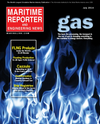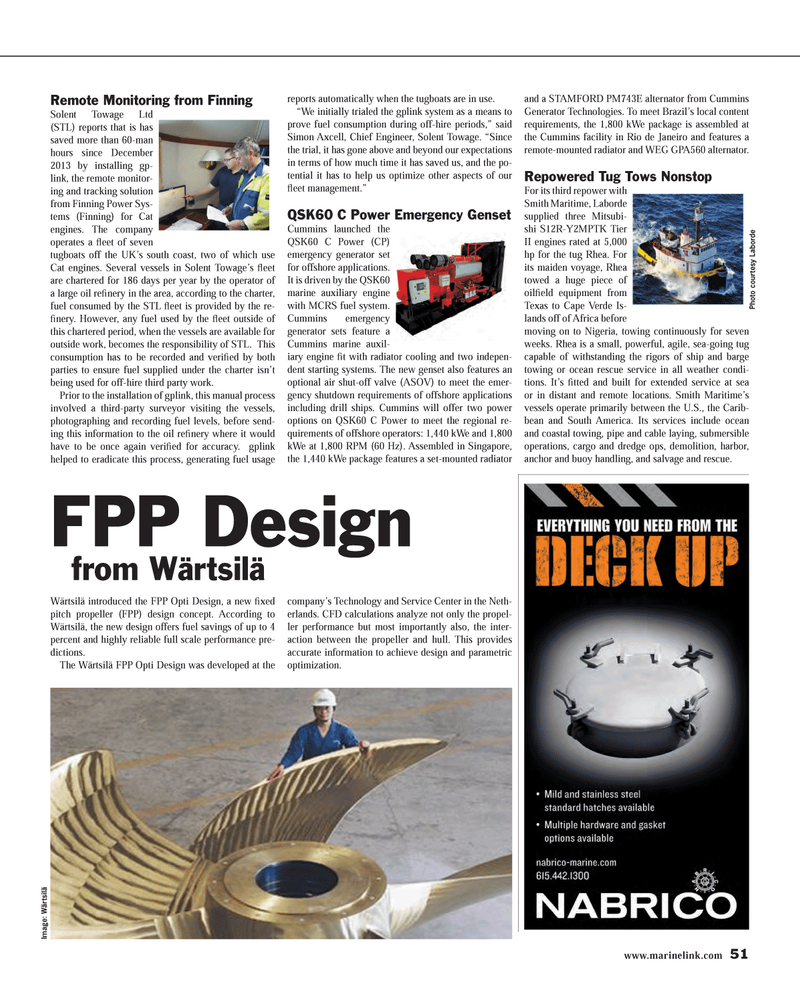
Page 51: of Maritime Reporter Magazine (July 2014)
Offshore Energy Structures & Systems
Read this page in Pdf, Flash or Html5 edition of July 2014 Maritime Reporter Magazine
www.marinelink.com 51
Remote Monitoring from Finning
Solent Towage Ltd (STL) reports that is has saved more than 60-man hours since December 2013 by installing gp- link, the remote monitor- ing and tracking solution from Finning Power Sys- tems (Finning) for Cat engines. The company operates a fl eet of seven tugboats off the UK’s south coast, two of which use
Cat engines. Several vessels in Solent Towage’s fl eet are chartered for 186 days per year by the operator of a large oil refi nery in the area, according to the charter, fuel consumed by the STL fl eet is provided by the re- fi nery. However, any fuel used by the fl eet outside of this chartered period, when the vessels are available for outside work, becomes the responsibility of STL. This consumption has to be recorded and verifi ed by both parties to ensure fuel supplied under the charter isn’t being used for off-hire third party work.
Prior to the installation of gplink, this manual process involved a third-party surveyor visiting the vessels, photographing and recording fuel levels, before send- ing this information to the oil refi nery where it would have to be once again verifi ed for accuracy. gplink helped to eradicate this process, generating fuel usage reports automatically when the tugboats are in use. “We initially trialed the gplink system as a means to prove fuel consumption during off-hire periods,” said
Simon Axcell, Chief Engineer, Solent Towage. “Since the trial, it has gone above and beyond our expectations in terms of how much time it has saved us, and the po- tential it has to help us optimize other aspects of our fl eet management.”
QSK60 C Power Emergency Genset
Cummins launched the
QSK60 C Power (CP) emergency generator set for offshore applications.
It is driven by the QSK60 marine auxiliary engine with MCRS fuel system.
Cummins emergency generator sets feature a
Cummins marine auxil- iary engine fi t with radiator cooling and two indepen- dent starting systems. The new genset also features an optional air shut-off valve (ASOV) to meet the emer- gency shutdown requirements of offshore applications including drill ships. Cummins will offer two power options on QSK60 C Power to meet the regional re- quirements of offshore operators: 1,440 kWe and 1,800 kWe at 1,800 RPM (60 Hz). Assembled in Singapore, the 1,440 kWe package features a set-mounted radiator and a STAMFORD PM743E alternator from Cummins
Generator Technologies. To meet Brazil’s local content requirements, the 1,800 kWe package is assembled at the Cummins facility in Rio de Janeiro and features a remote-mounted radiator and WEG GPA560 alternator.
Repowered Tug Tows Nonstop
For its third repower with
Smith Maritime, Laborde supplied three Mitsubi- shi S12R-Y2MPTK Tier
II engines rated at 5,000 hp for the tug Rhea. For its maiden voyage, Rhea towed a huge piece of oilfi eld equipment from
Texas to Cape Verde Is- lands off of Africa before moving on to Nigeria, towing continuously for seven weeks. Rhea is a small, powerful, agile, sea-going tug capable of withstanding the rigors of ship and barge towing or ocean rescue service in all weather condi- tions. It’s fi tted and built for extended service at sea or in distant and remote locations. Smith Maritime’s vessels operate primarily between the U.S., the Carib- bean and South America. Its services include ocean and coastal towing, pipe and cable laying, submersible operations, cargo and dredge ops, demolition, harbor, anchor and buoy handling, and salvage and rescue.
FPP Design from Wärtsilä
Image: Wär tsilä
Photo cour tesy Labor de
Wärtsilä introduced the FPP Opti Design, a new fi xed pitch propeller (FPP) design concept. According to
Wärtsilä, the new design offers fuel savings of up to 4 percent and highly reliable full scale performance pre- dictions.
The Wärtsilä FPP Opti Design was developed at the company’s Technology and Service Center in the Neth- erlands. CFD calculations analyze not only the propel- ler performance but most importantly also, the inter- action between the propeller and hull. This provides accurate information to achieve design and parametric optimization.
MR #7 (50-58).indd 51 7/1/2014 12:16:06 PM

 50
50

 52
52
